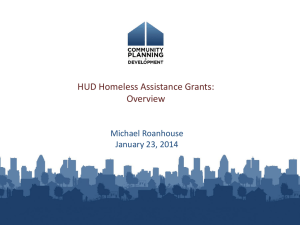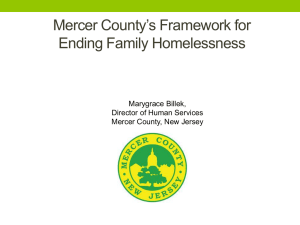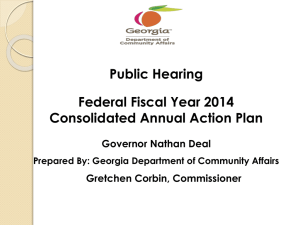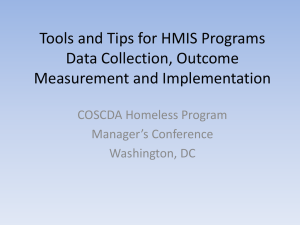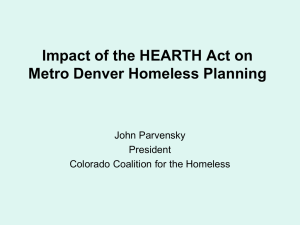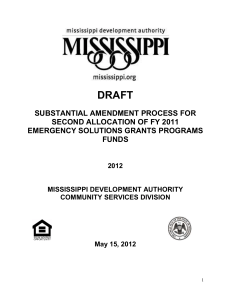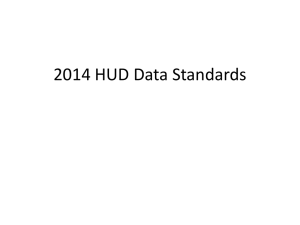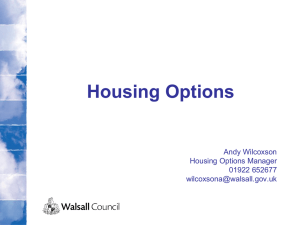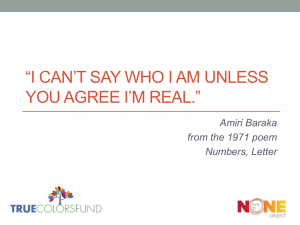The HEARTH Act
advertisement
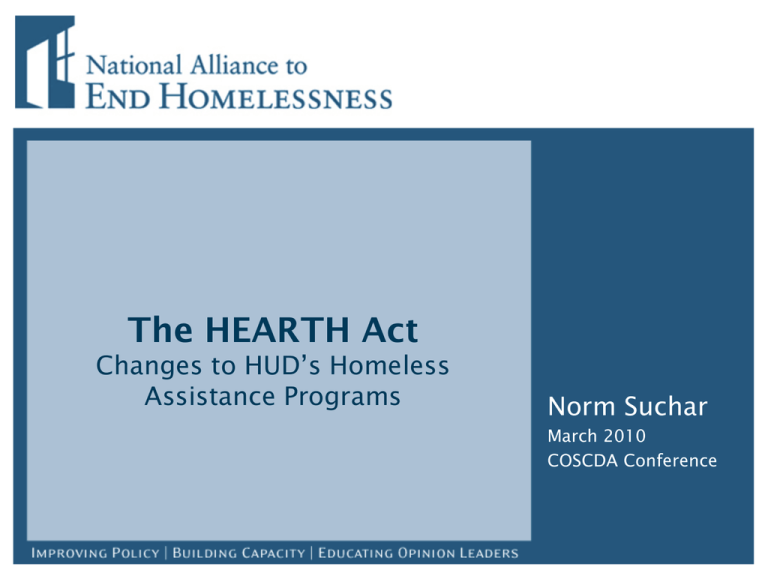
The HEARTH Act Changes to HUD’s Homeless Assistance Programs Norm Suchar March 2010 COSCDA Conference Overview • HEARTH Act • Enacted May 20, 2009 • Changes HUD’s McKinney-Vento Homeless Assistance programs • First significant reauthorization since 1992 Overview • Major Changes • More Administrative Funding • Emphasizes – Prevention – Rapid Re-Housing – Chronic homelessness • Focus on Outcomes • Rural Option Overview • Timeline • Most changes take effect in the NOFA released in Spring/Summer 2011 • Regulations Spring, Summer, or Fall 2010 • Public comment period • Some changes phased in over several years Formula and Competitive Funding Old (2008) Formula (ESG) 10% Competitive (CoC) 90% New Formula (ESG) 20% Competitive (CoC) 80% Changes to the ESG (Formula) Program Old Name: Emergency Shelter Grants Distribution: Formula to Cities, Counties, and States Admin: Up to 5% for administrative expenses Eligible Activities: –Shelter renovating, rehab, conversion –Operating Emergency Shelter (limit of 10% for staffing) –Services in Shelter or for outreach (max. 30%) –Prevention (limited, targets people with sudden loss of income, max 30%) New Name: Emergency Solutions Grants Distribution: Same Admin: Up to 7.5% for administrative expenses Eligible Activities: –Same as now plus HPRP activities (except that prevention has to target below 30% of AMI) –No cap on prevention, services, or staffing –Minimum of 40% must be for prevention and Rapid Re-Housing (with a hold-harmless provision) Another way to look at ESG changes • New ESG = Old ESG + HPRP • Roughly the same amount of funding for emergency shelters • New funding for homelessness prevention and Rapid Re-Housing similar to HUD’s HPRP Continuum of Care (competitive) Program Old New 3 programs • Supportive Housing Program (SHP)—including permanent supportive housing, transitional housing, safe havens, and supportive services only projects • Shelter Plus Care (SPC)—rental subsidies for permanent supportive housing • Mod. Rehab./SRO—seldom used, provides long-term rental subsidies for moderate rehabilitation of single room occupancy buildings Single Continuum of Care program • Includes all of the eligible activities of the 3 former programs • More flexibility for mixing and matching eligible activities • Explicitly specifies re-housing services as an eligible activity • Up to 10 percent for admin. Costs (previous amount was 5% for SHP and 8% for SPC • Reasonable costs for staff training Continuum of Care (competitive) Application Old • Providers in community jointly apply for funding • Stakeholders in community review and rank applications • Application has two parts – Exhibit 1 is the community wide part, which includes information about the number of homeless people, community resources and gaps, and capacity to administer homeless assistance – Exhibit 2 includes individual project applications New • Similar to existing process. • Application will be submitted by Collaborative Applicant, which will be eligible for 3% of the communities award for admin. • Application includes plans, timelines, responsibilities, and measures. • Application will be more focused on performance, including: – Reducing duration of homelessness – Reducing recidivism – Reducing the number of people who become homeless Continuum of Care (matching funds) Old New Match requirement varies depending on activity Uniform 25% match except for leasing projects –25% for services, must be cash –100% for rental assistance, must be in-kind services –100% for construction/rehab –33% for operating expenses –No match for leasing –Match can be community-wide, meaning some projects can have higher matches to offset projects with lower matches –Match can be cash or in-kind when documented by Memorandum of Understanding Additional Requirements • Projects that serve families cannot refuse to serve families because of the age of the children (i.e. must serve families with adolescent children) • Projects must identify person who will be responsible for coordinating child’s education HMIS •HMIS is here to stay! Incentives Old New • Communities that score well on Communities that score well will be their application are eligible for a eligible for a bonus for proven bonus permanent supportive strategies, including— –Permanent supportive housing for housing project. • In some years, the bonus project individuals or families with children experiencing chronic homelessness had to serve individuals without –Rapid Re-Housing that serves homeless children experiencing chronic families –Other activities that HUD determines are homelessness. effective at reducing homelessness –Communities that fully implement a proven strategy can receive a bonus to do whatever they determine is necessary Unified Funding Agencies Old New Each project submits to HUD an application for funding, and HUD enters into a contract with each project sponsor HUD HUD Project Sponsor Project Sponsor Communities may designate a Unified Funding Agency to receive a direct grant from HUD and then subgrant to project sponsors Project Sponsor Project Sponsor Unified Funding Agency Project Sponsor Project Sponsor Unified Funding Agencies • A Collaborative Applicant could apply to become a Unified Funding Agency (UFA) or HUD could designate a Collaborative Applicant as a UFA • UFAs would be responsible for ensuring audits and appropriate fiscal controls • UFAs would be eligible for up to 3% of a communities award for administrative expenses (on top of the 3% that a collaborative applicant could receive) Rural Areas Old • Rural homelessness program was never funded. • Rural Applicants were treated the same as other applicants New Rural Continuums of Care may apply for funding under a different more flexible set of conditions –Allowed to serve people who are homeless or at risk of homelessness with their competitive funding –May use up to 20% of funding for capacity building –Compete with other rural programs for funding –More eligible activities Many of the details will be worked out in regulations. Rural Areas • Rural area defined as— • Being located in a rural state (Alaska, Idaho, Montana, Nebraska, Nevada, New Mexico, North Dakota, South Dakota, or Wyoming); • Being a CoC with no Metropolitan Statistical Areas; or • Being in a CoC with only a rural part of an MSA included in the boundary (HUD will provide more specific definitions later) Definition of Homelessness/Eligibility Old New Except for a small amount for prevention, homeless assistance could only serve homeless people which includes people living in the following places ESG funding can be used to serve people at risk of homelessness. All programs can serve homeless people, including those previously considered homeless and –On the streets or in a place not meant for human habitation –In an emergency shelter –In a transitional housing program –In housing, but being evicted within 7 days and not having resources or support networks to obtain housing –Fleeing domestic violence –People who are losing their housing in 14 days and lack support networks or resources to obtain housing –People who have moved from place to place and are likely to continue to do so because of disability or other barriers Communities may use up to 10% (more in some cases) of CoC funds to serve people who are living doubled up, or in motels. Additional Changes • Bigger capital grants • Non-competitive renewals for PSH • 15-year contracts subject to funding for projectbased PSH • All Permanent Housing Activities are adjusted for inflation at renewal •What Does It All Mean??? Major Changes • More Administrative Funding • Emphasizes – Prevention – Rapid Re-Housing – Permanent Supportive Housing for Chronic Homelessness • Focus on Outcomes • Rural Options More Administrative Funding • • • • • • HEARTH Allows up to— 3 percent for Collaborative Applicant 3 percent for Unified Funding Agency 7.5 percent for ESG 10 percent for CoC Project Sponsors Comes out of the same funding as for programs Collaborative Applicant/UFA Options • Models for Administering ESG/CoC – City/County/State led – Non-profit led • Funder (e.g. United Way) • Dedicated Entity (Community Shelter Board) – Public/Private Unified Funding Agencies Old New HUD Project Sponsor Project Sponsor HUD Project Sponsor Project Sponsor Unified Funding Agency Project Sponsor Project Sponsor Why Unified Funding Agency? • More responsive to project sponsors • Align funding resources • Align reporting and requirements Fresh Start • This is a chance to fix things that don’t work! • Who is part of the CoC • Should you consolidate CoCs • Better integrate ESG/CoC/TYP New Focus: Prevention and Rapid Re-Housing Old ESG HPRP ? New ESG CoC Incentives • Rapid Re-Housing for families with children • Permanent Supportive Housing for individuals and families experiencing chronic homelessness. Performance • New Measures – Length of Stay – Recidivism – Newly Homeless • Can you measure these? • Can you manage for these? • Can you influence these? Get Ready • Who will be the Collaborative Applicant? Are they ready? • Can we perform? HMIS ready? • Which HPRP programs will continue? • Ten Year Plan Contact • • • • • Norm Suchar Senior Policy Analyst National Alliance to End Homelessness nsuchar@naeh.org www.endhomelessness.org
